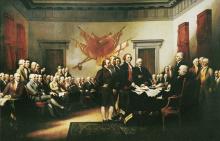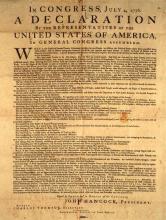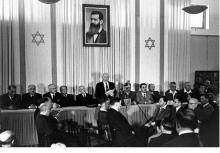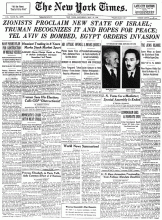Module 1: Israel and the United States: A Tale of Two Democracies
israelis-celebrating-independence.jpg

Outcomes:
- Students will identify key values as expressed in Israel’s Declaration of Independence, noting similarities and differences between Israel’s Declaration and that of the United States.
- Students will articulate the role played by values in a country’s life and decision-making processes.
- Students will frame one or more reasons, expressed in Megillat Ha'atzmaut, that there was a need for a sovereign Jewish democratic state at the time of the writing of the document.
I. Opening activity:
1. Engage in two whips writing down participants’ responses:
- The Declaration of Independence is necessary (important) because...
- A democratic country is necessary (important) because...
2. Summarize student perspectives on both the role of a declaration of independence and the nature of a democracy.
3. Describe the key questions of this module:
- How does a country’s history influence the values it chooses to embrace?
- Why does a country need values?
- What is the relationship between a country’s values and its character as a democratic state?
II. Second Activity: United States’ Declaration of Independence
- The goal of this activity is to draw out participants’ perceptions of democracy based on their own experience in the United States.
1. Text study: The United States’ Declaration of Independence:
In pairs or groups of three, ask students to read the excerpts from the U.S. Declaration of Independence (**click here for Excerpts Handout**) and, using the attached worksheet (**click here for worksheet**) or a Google Doc, fill out the sections on the right side pertaining to the United States:
- Row 1: Why the U.S. needs independence
- Row 2: The values articulated in the text
2. Debrief:
- Quickly ask students to name the values found in the text (ask one student to record either on board, Google Doc, or newsprint).
- Ask students to share why the framers of the text felt the need to declare independence from Great Britain – i.e. what was the historical imperative?
3. The Declaration in My Life:
- Using the values found in the U.S. declaration (life, liberty, pursuit of happiness, equality, etc.), participants should either go online or use newspapers or magazines made available, to:
- Illustrate examples of the values as they are seen in the U.S.
- Illustrate examples of when the values are not in evidence in the U.S.
- Participants should either create a prezi or mount their examples on newsprint and be prepared to share what they have found with the others.
- Viewing the presentations: As the presentations are shared (either as a walk through museum with newsprint posted on the wall or on screen), participants should write down their reactions.
- Share reactions.
4. Summary of this section:
- The United States, using the values as stated in its Declaration of Independence, defines itself as a democracy.
- As we have seen, the values as stated in the Declaration are evident but not fully so.
- The goal of the democratic process is to try to ensure that all citizens have the opportunity to realize the core values of the democracy.
If the module is done in two sessions, the second session should start here:
III. Third Activity: Israel’s Megillat Ha'atzmaut (Declaration of Independence)
- The goal of this section is to introduce participants to Megillat Ha'atzmaut and set the stage for the remainder of the modules.
Participants will:
- study excerpts from the document
- compare and contrast it with what they learned about the United States’ declaration
- draw some conclusions as to how Israel as a democracy differs from the United States
Setting the stage:
Israel was declared a state on May 14, 1948. Today we will recreate on film what that day was like. You will learn what it should feel like based on reading the text of the actual Israeli Declaration of Independence – Megillat Ha'atzmaut.
1. Text study: Creating our own moment of independence
- Divide participants into two groups. Each group will be asked to recreate the initial reading the excerpted Megillah (Israel Declaration of Independence) and make a movie of it using a smartphone or iPad/tablet. In order to do this, they should read the excerpts and try to extract from it the emotions that might have been on the minds of its framers (**click here for excerpts**).
- Their presentation will be judged on how authentic it feels in terms of the emotion and emphasis.
2. Viewing:
- Each group will show its video and the other group will note the emotion and emphasis the other group chose.
3. Debrief:
- How were the presentations the same or different?
- To what do you ascribe those differences?
- What did you think were the most important or core values put forth by the framers? (These should be noted in writing on a board or newsprint).
4. Present compiled footage from class:
- The videos will be combined into one reading at the end, viewed as a whole and compared with the footage from the actual reading on May 14th (don’t share this yet!).
- Unlike the U.S. declaration, we actually have footage of what it was like on the day that Israel declared independence.
5. Present footage of original declaration and ask:
- What are the emotions you see?
- Does anything surprise you?
- How is this similar or different to what you imagined?
- How does this differ from your image of what it looked like when the U.S. Declaration of Independence was signed?
- You can show the painting of the signing, if you want.
IV. Summary:
Display the values participants drew out of the U.S. Declaration beside those of Israel’s Megillah.
- What similarities and differences do participants notice?
- Ask them to conjecture why these similarities and differences exist, based on what they know about the historical reasons for declaring independence (from their text studies).
- Ask participants to keep in mind the images they created of the U.S. values in action (maybe keep them hanging up or, if they are on prezis, see if you can print them out and hang them up) during the next several sessions/weeks as we explore how the values of Israel’s Megillah play out.
Close this activity by stressing the connection between the values in the Megillah and the values that we all want to share as we build a community together.





%20-%20May%2016%2c%201948_0_0/index.jpg?itok=bgn9XUEf)
